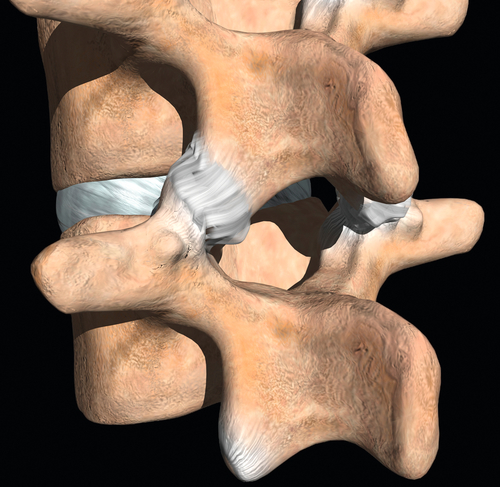CHAPTER 46
Lumbar Facet Arthropathy
Definition
Lumbar facet joints are formed by the articulation of the inferior and superior articular facets of adjacent vertebrae (Fig. 46.1). These joints, located posteriorly in the spinal axis, are lined with synovium and have highly innervated joint capsules. Lumbar facet arthropathy refers to any acquired, traumatic, or degenerative process that changes the normal function or anatomy of a lumbar facet joint. These changes often disrupt the normal biomechanics of the joint, resulting in hyaline cartilage damage and ultimately periarticular hypertrophy. When they are painful, these joints may limit activities of daily living, work, and recreational sports. Lumbar facet joints may be a primary source of pain, but they are often painful concomitantly with a degenerative or injured lumbar disc, fracture, or ligamentous injury.

Lumbar facet arthropathy is more severe at the L4-L5 level and is common with advancing age and progressive intervertebral disc disease. These findings are independent of race and sex [1,2]. Postsurgical facet joint pain appears to be associated with advancing age, prolonged intraoperative time, intraoperative complications, discectomy, history of recurrent disc prolapse, and lack of rehabilitation [3,4].
Symptoms
Patients often complain of generalized or lateralized spinal pain, sometimes well localized. Pain may be provoked with spinal extension and rotation, from either a standing or a prone position. Relief with partial lumbar flexion is common. In the lumbar spine, these joints may refer pain into the buttock or posterior thigh but rarely below the knee [5–7]. Neurologic symptoms, such as lower extremity weakness, numbness, and paresthesias, would be unexpected from a primary facet joint disorder.
Physical Examination
A detailed examination of the lumbar spine and a lower extremity neurologic examination are considered standard procedure for those thought to have facet arthropathy. Although no portion of the examination has been shown to definitively correlate with the diagnosis of a facet joint disorder, the physical examination can be helpful in elevating the clinician’s level of suspicion for this diagnosis [8,9]. The examination starts with simple observation of the patient’s gait, posture, movement patterns, and range of motion. Generalized and segmental spinal palpation is followed by a detailed neurologic examination for sensation, reflexes, tone, and strength. In the absence of coexisting pathologic processes, such as lumbar radiculopathy, strength, sensation, and deep tendon reflexes should be normal.
Provocative maneuvers and nerve tension tests, including straight-leg raising, should accompany the evaluation to rule out any superimposed nerve root injury that might accompany a facet disorder. The clinician notes the patient’s response when the lower extremity is raised with the hip flexed and the knee extended. This “tension” placed on inflamed or injured lower lumbosacral nerve roots will provoke pain, paresthesias, or numbness down the extremity. Typically, in isolated cases of lumbar facet disorders, this maneuver does not provoke radiating symptoms into the lower extremity, but it may cause lower back pain. Some physicians find that facet pain can be reproduced with prone extension with rotation, hip extension, lumbar extension while standing on a single leg, and standing spinal extension.
Functional Limitations
Patients with lumbar facet joint arthropathy may experience difficulty with prolonged walking, stair climbing, twisting, standing, and prone lying. Because facet problems are common with underlying disc disease, patients often have difficulty with lumbar flexion activities, such as lifting, stooping, and bending.
Diagnostic Studies
Fluoroscopy-guided, contrast-enhanced, anesthetic intra-articular or medial branch blocks are considered the “gold standard” for the diagnosis of a painful lumbar facet joint (Figs. 46.2







